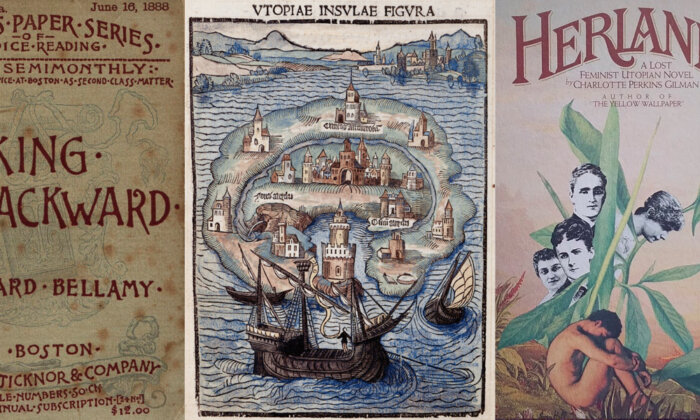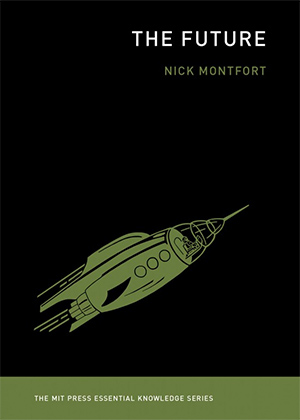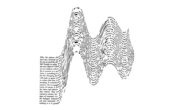Writing the Future With Utopias

If we start our search for utopias from the United States, one vision, and one particular book, looms particularly large. This is Edward Bellamy’s 1888 novel, “Looking Backward: 2000–1887.” Set in Boston in the year 2000, it follows the experiences of a man who, like an even more dormant Rip Van Winkle, entered a trance in 1887 and was brought out of his suspended animation in good health more than 100 years later. What he found, as the book’s preface explains, was “a social order at once so simple and logical that it seems but the triumph of common sense.” He tours the city, learning about the improved working conditions and the abundance of food and goods available to everyone. Boston, and the United States, have been transformed into a bountiful socialist utopia.

Soon after the novel was published in 1888, its publisher was acquired, the book was reissued, and it became tremendously popular. A million copies were sold in two years, with only “Uncle Tom’s Cabin” and “Ben-Hur” outselling it, and in those cases over a longer span of time. Dozens of clubs were started to discuss the socialist ideas of the book. These groups, organized by “Bellamyites,” were called “nationalist clubs” because of negative associations with the term “socialism,” but they were closely related to the concept of socialism and did not have any particular relationship to what we now think of as nationalism. These clubs were only around for a few years, but they, and Bellamy’s book, were an important influence on the Theosophical movement, which went on to establish a dozen utopian communities in the United States. The impact on American writing was strong, too, with more than 150 books being written in response to “Looking Backward” — including exuberant sequels and several books opposed to the ideas of the original novel.
The new society in “Looking Backward” is based on ideas that precede the book; this society is also presented well in the context of the novel. The narrator, Julian West, is from the same time as his early readers, and it’s of course necessary for people from the year 2000 to explain to him how this strange new society works. The difference between the improved social order and that of 1887 is illustrated throughout the book, but perhaps never as memorably as when the narrator finds that a sudden downpour has begun and he — and, it seems, everyone else — is without an umbrella: “The mystery was explained when we found ourselves on the street, for a continuous waterproof covering had been let down so as to enclose the sidewalk and turn it into a well-lighted and perfectly dry corridor, which was filled with a stream of ladies and gentlemen dressed for dinner.” As one of the natives explains, “the difference between the age of individualism and that of concert was well characterized by the fact that, in the nineteenth century, when it rained, the people of Boston put up three hundred thousand umbrellas over as many heads, and in the twentieth century they put up one umbrella over all the heads.”
Bellamy’s novel presents a society of abundance in which each person is allotted a specific amount of what is produced, a bounty that is clearly greater than anyone would need but is still regulated. To mete out the many goods, Bellamy introduced what he called the “credit card,” the first use of the term, although it didn’t actually allow purchases on credit. Industries have been nationalized in the book, and this credit card system allows for the equal distribution of goods. Rather than paying anyone more, those who have to do particularly unpleasant work simply get to work fewer hours. Women have a more equal role in society and are part of the workforce, although “the heavier sorts of work are everywhere reserved for men, the lighter occupations for women.”
The plausible portrayal of women working in all roles in society was meant to show that — even in a society that has both men and women — it does not make sense to restrict women to only a few social roles.
Another intriguing model society, which responded to this particular aspect of Bellamy’s, was presented by American author Charlotte Perkins Gilman in her novella “Herland,” originally published in 1915. In this book, three adventurous men locate an isolated community that is entirely female. (The women of “Herland,” it is explained, are able to reproduce without men.) The girls and women are highly accomplished at all necessary work, from tasks that are traditionally considered feminine in U.S. culture, such as child-rearing, to building houses. They prosper, eschewing rote learning, governing their society deliberately, and wearing clothing that has numerous pockets.
While “Herland” does offer some suggestions as to the social order, and promotes certain types of feminist thought about society, it seems unlikely that Gilman was literally suggesting that the best society would be a secluded, nonindustrial one with only women. More likely, her plausible portrayal of women working in all roles in society was meant to show that — even in a society that has both men and women — it does not make sense to restrict women to only a few social roles. Aside from the implausibility of asexual reproduction, critics take issue with some other aspects of “Herland,” including its attitude toward native people, who are repeatedly disdained as “savages.” Despite such flaws, the novel remains a powerful work of imagination, particularly given that it was published before women even had the right to vote throughout the United States.
Utopian writing existed long before Bellamy and Gilman, of course. Plato first developed an ideal society of philosopher-kings (a community that entirely excluded poets) in his “Republic,” which predated the Christian Era by almost four centuries. But the genre of writing takes its name from a short book in Latin by Thomas More, “Utopia,” which was published in 1516. The book isn’t, strictly speaking, about the future — it describes a fictional society of that time. But it clearly suggests some ways that Western, and particularly English, society could be different in times to come. The book describes the highly systematic functioning of island residents, people who behave in many ways like monks following the Rule of Saint Benedict: They live communally, doing manual labor. More’s Utopia has been described as “a communist community, enhanced by Christian values.”
There are a few differences from either the modern-day communist concept or monastic life, of course. Unlike a monastery, the land of “Utopia” is a heterosocial place, and people get married and raise children. Each person who is about to marry is presented with his or her potential partner, naked, and allowed an inspection — sensible, More explains, because one considers even a horse very thoroughly for any sign of ill health before purchasing it. It seems difficult to understand this procedure as a serious proposal, but, at the same time, it might point out that marriage is impractical between two people who know very little about each other in other ways. Why would we demand to take the saddle off the horse and inspect it closely while not giving the same concern to our betrothed?
One lesson in future-making — or imagining and consciously trying to contribute to a particular future — that can be seen here is that utopian ideas don’t have to be entirely serious to be effective in provoking people to change their thinking and move toward a better future. The pre-marriage inspection can be read in several ways — as making fun of people’s obsession with physical attractiveness, for instance, or as making fun of marriage as an institution that establishes ownership, like the ownership of a horse, of one person by another.
Even implausible aspects of utopian fiction can be useful. They can point out, as with any satire, how outrageous our current society is.
“Utopia” is almost certainly not a full-on parody of More’s society. It presents an alternate society in which there are few laws, people live communally and sustain themselves by cultivating and making what they need, and people pursue learning throughout their lives. Most of the ideas are presented, as with Plato’s “Republic,” as ways society could be reordered and improved. So, it’s interesting to see a few cases in which the customs of the Utopians strain credulity. One effect that this can have is stimulating multidimensional thinking about current society and the way that it’s organized. Another effect is that it can remind us to be critical and thoughtful. Even if we like the direction an author is taking and the type of society that is being proposed, we shouldn’t accept every new idea presented as if it were a new doctrine.
More’s Utopia, Bellamy’s year-2000 Boston, and Gilman’s all-female society are all presented as ideal, or close to ideal, as was the republic that Plato described. Those who study utopian thought and writing distinguish, however, between a utopia or “no place” and a eutopia or “good place.” A utopia is an invented society, existing beyond history as an alternative to present societies, but it doesn’t have to be perfect. It doesn’t even have to be better, so a fictional society that is presented as negative and deeply flawed, a dystopia, can also be seen as a type of utopia. There are also notable novels that are set “no place” and present societies that have some positive and some negative aspects; these include Jonathan Swift’s “Gulliver’s Travels” and Samuel Butler’s “Erewhon.”
One way that utopias can function is by portraying a plausible alternative to the current social configuration. More’s book prodded readers to think about how communal living without private property might be possible. Bellamy’s made it seem plausible that a well-planned society could produce more than enough for everyone to live well and could happily distribute that wealth equally rather than leaving some in poverty. And, even if readers of Gilman’s book didn’t think that an all-female society was actually the best idea, they could probably believe many aspects of the portrayal of women working in every possible role in a community. If we can imagine such possibilities within the framework of fiction, this can make it easier to think of them in our own reality.
Even implausible aspects of utopian fiction can be useful. They can point out, as with any satire, how outrageous our current society is. They can also encourage us to think critically as we imagine a better society. Also, they might help to expand the limits of what we consider possible. Because utopian fiction takes us away from the specifics of our current place and situation and transports us to no place, it allows us to come to new insights that can then be applied to the world we live in. Perhaps an all-female society existing for thousands of years isn’t plausible, but if it were, wouldn’t the women in it be capable of doing anything that was needed? If so, isn’t it reasonable to allow women to occupy any role in our mixed-gender society? Utopian thinking is of course often associated with silliness and impossible, impractical ideas, but when it’s done effectively, shifting our thinking from our current place to no place can help us get out of a rut.
A future-maker might do something clever by coining a term or inventing something specific. This can be useful, but this is seldom as powerful as developing an overall, coherent vision that can be worked toward, engaged with deeply, or opposed. Although it’s interesting to note that Bellamy is (at least approximately) the inventor of the credit card, his real influence is seen in dozens of organizations founded to think through and promote his work, and the dozens of books written to continue the conversation he started.
There is room in a utopia for plausible, sensible alternatives to today’s practices. Likewise, there is room for the absurd and the outrageous, which can provoke our critical faculties, opening our minds to unusual — and transformative — ideas.
Nick Montfort is a professor of digital media at MIT. He is the author or co-author of several books published by the MIT Press, including “The Future,” from which this article is adapted.
Related titles in the MIT Press Essential Knowledge series:




